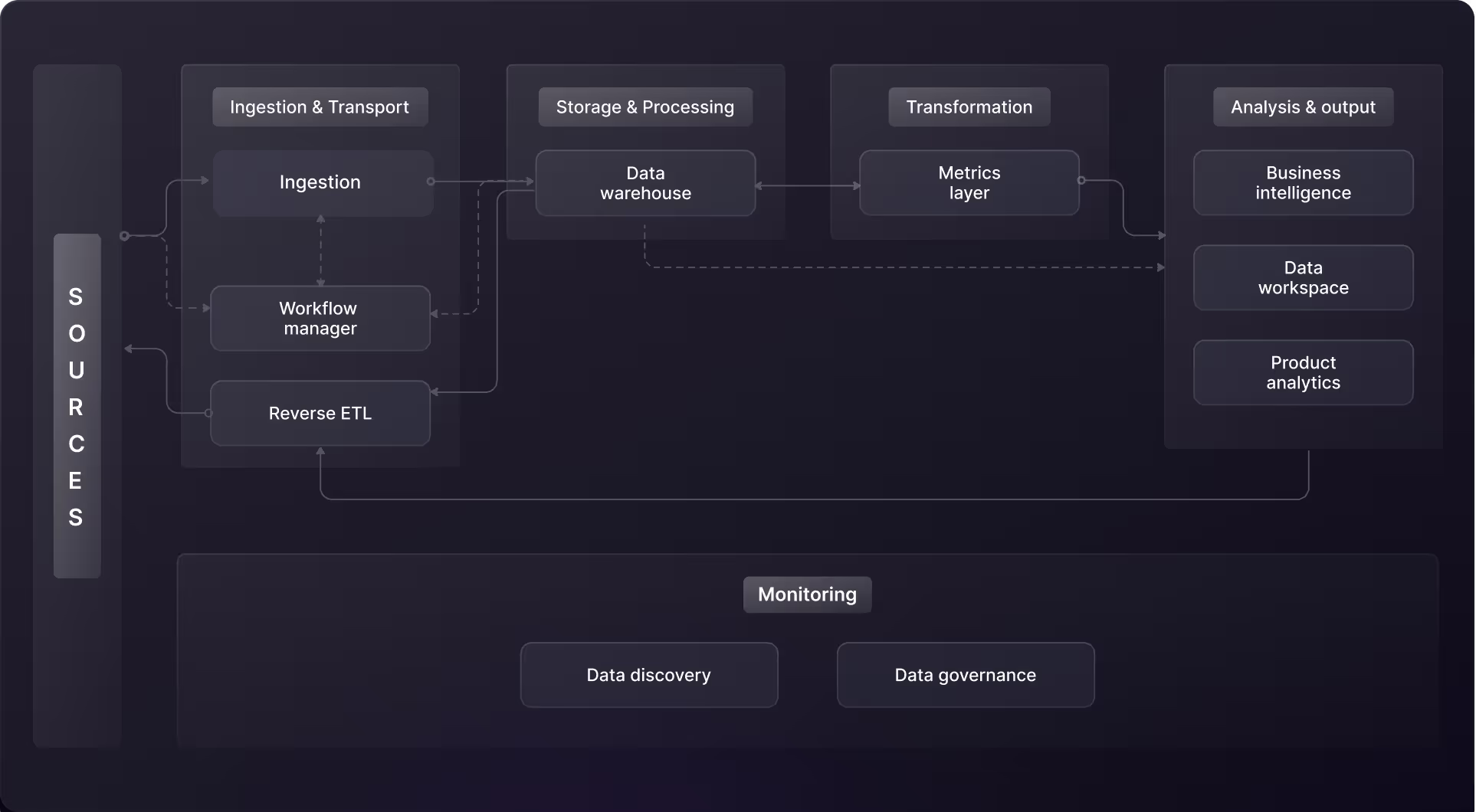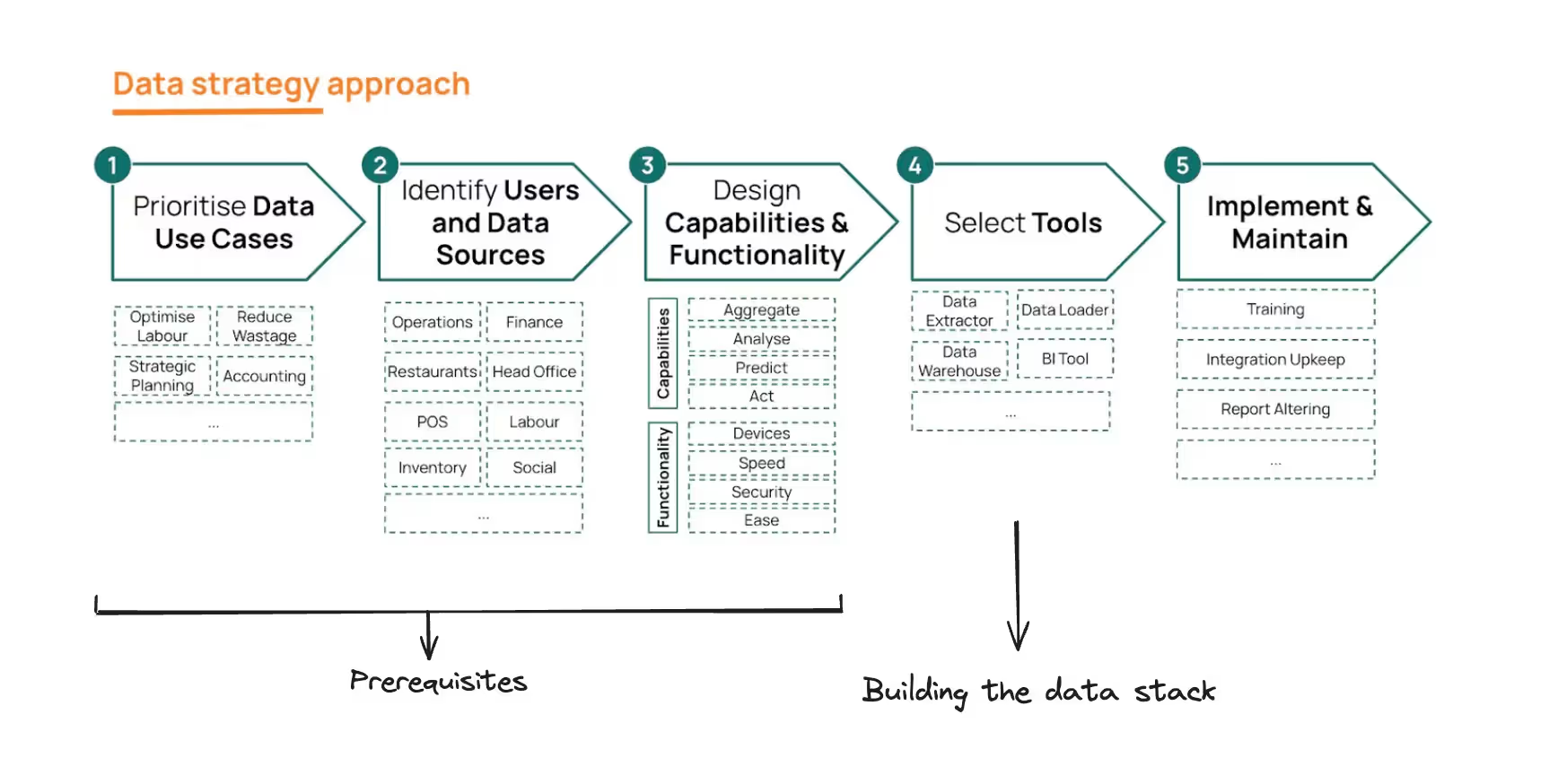Table of Contents
TL; DR
Your restaurant is sitting on a goldmine of data. A treasure you could use to unlock growth. The missing piece? A data platform to bridge the gap from raw data to usable insights.
Restaurants have ample data—be it from the POS, reservation, inventory management, CRM, online ordering apps, feedback surveys, or employee management software. (You see? It’s omnipresent!)
You have two choices:
- let all this data sit unused, like most companies where 68% of data is untapped, or
- use it wisely to improve your operations and increase profits.
To do this, you need a data stack, which is basically a set of tools that collect, store, process, and analyze data. A robust data stack ensures that your operations can easily adapt as your business expands. It becomes the foundation for a future-ready system that supports your restaurant's growing data needs.
This is how a restaurant chain's data stack looks like:

Building a data stack is not just a technical necessity but a strategic one, especially as your restaurant grows. It goes a long way in shaping your restaurant’s growth and revenue.
If your restaurant is still figuring out the whole data stack thing, or you're in the middle of putting it together, keep reading! We share the exact steps to quickly get you started with building a scalable one so your restaurant runs better and makes more money over the long haul.

Roadblocks in using data at restaurants
The current approach is messy and all over the place. Data flows from dozens of sources like the POS and CRM, and connecting the dots manually takes too much time.
In fact, many restaurants don't prioritize data analytics. Because, honestly, there are challenges in getting everyone on board:
- Lack of awareness: Some restaurateurs may not fully understand the potential benefits of using data in their daily ops.
- Time constraints: Operations can be demanding, leaving little or no time for restaurant owners to focus on data analysis.
- Tech barriers: They may face challenges in adopting new tech if they are using legacy tools for basic analysis.
- Lack of expertise: They may lack staff with the skills or knowledge to interpret and use data.
- Perceived complexity: Some restaurants might avoid using data tools thinking they're too complex to operate.
But here's the catch! These are solvable problems. It requires a mindset shift from being hesitant about data to embracing it for a broader adoption within the restaurant.
Our recent blog on restaurant analytics shares some great tips to get started.
Despite all these challenges, there are several reasons you should consider building a data platform for your restaurant.
How a data stack can help restaurants grow faster
Let’s look at some numbers before getting into the details:
Restaurants that used data analytics, noticed a
- 10% increased revenue
- 15% reduced operating costs
- 20% improved EBITDA
But how do you reach these numbers? A cohesive data strategy and a well laid out data stack that turns raw data from various sources into meaningful insights.
Here’s how a data stack can help restaurants:
- Break down data silos: If data is siloed across POS, CRM, and other systems, it can be a serious challenge to analyze it. A central data warehouse breaks down these silos to store this data centrally. It is then further sent for transformation and visualization. So, a data stack consolidates data making it easier for the whole team to make sense of it.
- Optimize ops, save big: A data stack can provide insights on customer preferences based on data from POS and CRM. The team can use these insights to optimize menus, reduce waste, and simplify daily tasks like order-taking, food prep, and staff coordination. This not only streamlines operations but also brings substantial cost savings for restaurants.
Fun fact: Data has a secret talent: it moonlights as a detective to bust internal thefts at restaurants. Yep, we caught it in the act for one of our clients. Sneaky, right?
- Menu makeover = more customers: A data stack figures out which dishes customers love and which ones need improvement by looking at sales patterns. This can help restaurants optimize their menu and make it a curated selection of crowd-pleasers. It goes beyond identifying the top-selling and least-selling items. Understanding sales patterns and customer preferences also helps fine-tune the pricing point, right portion sizes, and promotions to draw more people in.
- Comprehensive metric tracking: Restaurants thrive on detailed insights into operations. A data stack can provide the granularity needed to examine key metrics across sales, customer service, marketing, inventory and other areas closely. It allows teams to monitor cross-functional metrics, offering a more comprehensive understanding of restaurant operations.
- Real-time unit economics: Timeliness is key in the restaurant industry. A data stack helps restaurants understand real-time unit economics by keeping a close eye on the key financial metrics for each item they sell or service they provide. It tracks costs, revenue, and how well things are running. This allows restaurant owners to quickly check and decide on the best prices, manage expenses, and improve overall profitability. Think of the data stack like a financial mentor, always keeping restaurants up to date on how each part of the business is doing.
- Bye bye audit stress: During audits and inspections, health authorities and regulatory bodies check food safety, cleanliness, and adherence to operational standards. Instead of searching through piles of paperwork during audits, the data stack gives quick access to these reports. This not only ensures compliance but also saves time and stress for restaurant owners, proving their dedication to high standards.
- Automate processes: The coolest thing about a data stack is that it automates and makes processes like order handling, keeping track of inventory, and planning staff schedules super smooth. It does this by gathering and studying data from various sources. Plus, it can be smart enough to figure out trends, like predicting which dishes will be a hit or managing supplies really well. It can even tell when the busy hours are based on past data, so there's the right number of staff during peak hours.
Imagine you have a data stack set up for your restaurant. When a customer places an order, the data stack doesn't just record the details–it automatically analyzes the order patterns. For instance, if every Friday night people tend to order more pizza, the data stack learns and predicts that trend.
Now, when it comes to inventory, the data stack doesn't wait for someone to check and reorder supplies. It uses the patterns it learned, like the increased demand for pizza on Fridays, to automatically trigger inventory updates. So, it ensures that there's enough dough, cheese, and toppings ready without manual input.
Similarly, for staff scheduling, the data stack looks at historical data to predict busy hours. If, based on past Fridays, it knows that 7 PM is the peak time for pizza orders, it automatically schedules more staff during that time, ensuring a smooth workflow.
In essence, data stack automation is about the system learning from patterns and making smart decisions on its own, making order processing, inventory management, and staff scheduling way more efficient.
- Ultimately, competitive advantage: The process improvements with a well-rounded data strategy and stack can help build a solid foundation for long-term success by adapting to market fluctuations, implementing cost-effective measures, and delivering value to stakeholders.
Exciting, isn't it? The possibilities are endless. You can do this too! Just follow these tips to create your own data stack and watch your success story unfold.
How to build a restaurant data stack in 5 steps

Prerequisites for building a restaurant data stack
Creating a successful data stack starts with:
Defining your goals
Identify what you want to achieve with your data stack. Are you looking to streamline work, cut down on waste, plan better, manage inventory, or optimize pricing?
Knowing your users
Figure out who will use the insights from your data system. Is it your operations, finance, POS, kitchen, marketing, or social media teams? Knowing your users helps tailor the data to their needs.
Choosing the right metrics
Decide on the specific metrics you want to track. This usually includes basic metrics like revenue, profits, operation costs, total orders, and average order value. Customize the metrics based on the end user’s needs.
Checking your tech stack for compatibility & functionality
Ensure your POS, ERP, and CRM systems can efficiently gather and analyze sales, customer, and operational data. Make sure that these tools work well on different devices, process data quickly, maintain security, and are user-friendly for your restaurant team. Lastly, ensure your current tech stack has API capabilities to integrate with the new tools.
Facing these aspects head-on is crucial. Without it, you might put in months of effort only to discover that no one is interested in the data insights, or worse, you could end up with reports that nobody asked for.
Steps to build a scalable restaurant data stack
Your job is half done with cracking the above four things. Here’s what next you need to do:
Compare and procure vendors
A data stack involves tools that gather data from diverse sources, transporting it to a central warehouse. Next, a data transformation tool is employed to clean and reshape this data. The refined data is then sent to business intelligence tools, where it is converted into insightful reports and dashboards.
To choose the right tools for your data stack:
- Research: Look into different vendors offering tools that meet your use cases, budget, and size. Check out reviews, features, and pricing.
- Evaluate: Compare the options based on factors like functionality, ease of use, customer support, and cost.
- Demo and trial: Request demos or free trials to get hands-on experience with the tools before making a decision.
- Negotiate and procure: Reach out to the selected vendors, negotiate pricing and terms, and finalize contracts.
Find your best fit tools with our Buyer’s Guide series where we compare top vendors in each category and share some pro tips from our in-house engineers!
Implement your selected tools
Once you've chosen the right tools for your stack, the next step is putting them into action. Implementation involves:
- Installation: Follow the installation instructions provided by the vendor or seek assistance from their support team.
- Configuration: Customize the settings according to your restaurant's requirements, such as menu items, pricing, and user permissions.
- Data migration: Transfer existing data from your current systems like POS, ERP, and CRM to the new tools. Ensure there’s no loss in data quality during the migration process. This integration allows you to get the big picture by combining data from different sources. The goal is to have all tools working seamlessly together so the operations become smoother.
Ensure data quality & governance
Follow these best practices to ensure high data quality and governance:
- In spreadsheet tools like Excel, use functions to eliminate duplicates and standardize formats.
- Implement validation rules for error prevention during data entry.
- Establish basic governance by defining roles for data access within small teams.
- Set up automated alerts to catch issues early.
- For sensitive data, employ simple encryption tools like BitLocker or FileVault.
- Maintain a document outlining data usage guidelines and basic metadata.
Future-proof your data stack for scalability
Building a data stack isn't a set-it-and-forget-it deal. You should keep tweaking and maintaining it as the business grows. To make sure it's ready for whatever comes its way, here are five simple tips:
- Prefer cloud-based solutions: Choosing cloud-based solutions ensures that your data stack can handle growing amounts of data without significant performance issues. You can easily scale resources up or down based on demand, making them ideal for growth.
- Design flexible data models: Design adaptable data models and embrace a modular architecture for seamlessly adding tools in future. They allow your stack to accommodate changes to data pipeline structures without causing disruptions or requiring major overhauls.
- Prioritize automated scaling: Automated scaling is crucial to adapt resources dynamically based on demand. This approach ensures that your data stack can efficiently handle increased workloads without the need for manual adjustments so it adapts to changing requirements.
- Build a decentralized architecture: Distributing tasks across multiple servers or locations in a decentralized architecture allows for better handling of increased workloads. This way, the system can handle growing demands without centralized bottlenecks.
- Implement data partitioning: Data partitioning means dividing large datasets into smaller partitions for effective load distribution. This improves the system's ability to manage large volumes of data efficiently.
Train your staff to promote adoption
Training the restaurant team to use a data stack is important because it helps everyone excel in their roles, eventually contributing to the restaurant’s bottom line.
Chefs, for instance, can gain insights into popular dishes and optimize the menu. Operation managers use data to understand how well things are running, if customers are happy, and how resources are used. They can use this data to make processes smoother, create better staff schedules, and keep day-to-day operations running smoothly. Inventory folks can ensure they always have the right ingredients in stock.
Ensure everyone feels confident using data and understands that it's a way to make their work more manageable and impactful.
Cupbop saved 300+ hours/month using 5X-managed data platform
Cupbob’s “entertaining” take on Korean food has made it into one of the most loved local food chains in the U.S.
Their data challenge: Cupbop wanted a holistic overview of their business down to the store level and make data driven decisions that drive business growth.
What we did: 5X created a custom business-intelligence engine that shed light on performance across all aspects of Cupbop’s business. This was powered by a data platform that ingests data from all sources, cleans it up, & presents actionable insights. 5X went the extra mile to create custom connectors for Uber Eats, Square, & DoorDash.
And most importantly, 5X brought in a culture of data-driven decision-makingーour dedicated analysts worked closely with store level managers to uncover insights & make informed decisions that improved store revenue, utilization, & marketing ROI.
The results? A sea-change in how Cupbop operates! Automated data collection & reporting saved them 300+ man hours/month, 15% reduction in food costs, & 10X faster time-to-insight, and more to come. The insights from our analysts ensure that the organization's effort is being put in the right direction.
Don’t wait! Build your data stack today!
So...

…with or without 5X, your team will thank you for it.
The sooner you start using data, the higher the efficiency in operations and bigger your savings. There might be a few initial jitters if you don’t get the basics right. So start by identifying the use cases, users, metrics you want to track, and the tech stack’s compatibility. Follow it up with research on the best tools for your needs and implementing them into your stack. Lastly, don’t forget to train your staff as it sets the path for a widespread data adoption across the restaurant.
Building a data platform doesn’t have to be hectic. Spending over four months and 20% dev time just to set up your data platform is ridiculous. Make 5X your data partner with faster setups, lower upfront costs, and 0% dev time. Let your data engineering team focus on actioning insights, not building infrastructure ;)
Book a free consultationHere are some next steps you can take:
- Want to see it in action? Request a free demo.
- Want more guidance on using Preset via 5X? Explore our Help Docs.
- Ready to consolidate your data pipeline? Chat with us now.

How retail leaders unlock hidden profits and 10% margins
Retailers are sitting on untapped profit opportunities—through pricing, inventory, and procurement. Find out how to uncover these hidden gains in our free webinar.
Save your spot











%201.svg)

.png)
.png)






